Understanding Quality
Many coin experts broadly advise collectors to settle only for high quality coins. There is much truth to this, but more needs to be said. Exactly how are “high quality” coins defined and who are the collectors that should be picky? How does all this this relate to someone just getting involved with the hobby?
Let’s first acknowledge the term “quality” can be vague when it comes to coin collecting. A coin may be said to have “quality” in (at least) three distinct ways:
Of course, a “quality” coin may possess more than one of these traits. Let’s examine them in greater depth...
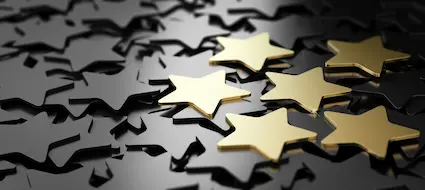

Condition, or Grade of a Coin
More often than not, the condition, or grade of a coin, is the yardstick associated with quality. The higher the grade of a coin, the better its state of physical preservation.
Of the three ways to define a quality coin, this one is the easiest to understand and compare, assuming we’re looking at properly graded coins (but as we have learned, assessing a fair and accurate grade can be filled with challenges).
For instance, a coin graded as Very Good-8 is of a higher quality than a Good-4. A Mint State coin rated as MS-65 is of a higher quality than an MS-60, and so on.
No collector of any status should feel compelled to attain only highly graded coins, or stretch themselves to buy the best affordable grade. This is especially true for newbie collectors, guidance that coincides with the Start out small approach.
Let’s say your first collecting goal is to build a full set of business strike state quarters, issued from 1999-2008. The least expensive method (and maybe the most entertaining) is to assemble the set drawn from circulation. Most of these quarters would display some wear and tear, but that’s okay if it’s acceptable to you. On the other hand, you could spend thousands of dollars acquiring certified MS-68 examples. At this point in your collecting career, opting for the lower grades makes the most sense because it protects you from making costly beginner mistakes while learning hobby basics.
Conversely, perhaps you’re an advanced Lincoln cent collector with above average financial reserves. Your personal library has a section devoted to the Honest Abe penny. You’ve followed the Population Reports for years and understand where true rarity and value in the series resides. You’ve closely examined thousands of Lincolns and have seen every color on the B-RB-RD spectrum.
Now, finally, the time has come to seek out the elusive 1926-S RD in MS-65 grade, where it ranks as the finest known of this date and is perhaps the most valuable coin in the entire Lincoln cent series. Word has gone out to your well-connected dealer acquaintances, who are in sync with your expectations. Reaching this goal may require patience for the right opportunity to come along. Until then, your $100K+(1) will just have to calmly sit idle.
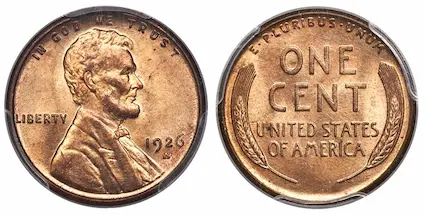
These situations illustrate that when it comes to grade quality, there are no rigid rules directing what grade of coins you should buy. It really boils down to the interests and comfort level of the individual collector.
For collectors who buy coins at least partially for the enjoyment of watching them rise steadily in value over time, it’s actually the second and third definitions of quality that deserve the most attention.
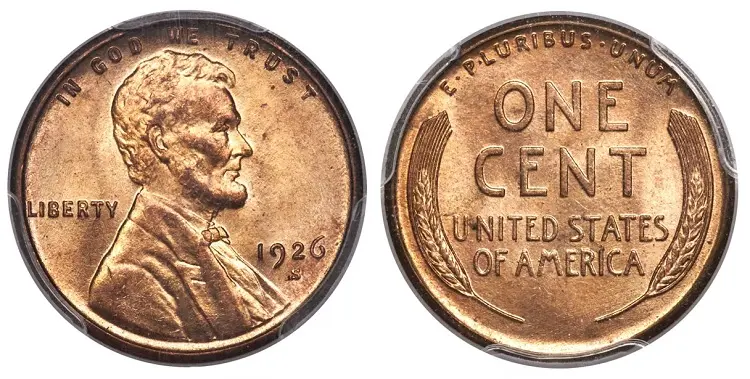
These situations illustrate that when it comes to grade quality, there are no rigid rules directing what grade of coins you should buy. It really boils down to the interests and comfort level of the individual collector.
For collectors who buy coins at least partially for the enjoyment of watching them rise steadily in value over time, it’s actually the second and third definitions of quality that deserve the most attention.
Collector Desirability
Another way of viewing a coin as “high quality” occurs when it is widely desired by the collector base, but whose availability is characterized by a limited supply relative to demand. In other words, the coin is coveted by numismatists, but there aren’t enough of them to go around, resulting in higher prices compared to other collectible coins with smaller demand and/or sufficient inventories.
Let’s look at a couple of examples…
Quarter eagle ($2.50 gold) type set collectors require at least one example from the following groups: Capped Bust (1796-1807), Capped Draped Bust (1808), Capped Head (1821-1834), Classic Head (1834-1839), Coronet (1840-1907), and Indian Head (1908-1929).
The “bottleneck” group is the Capped Draped Bust entry, minted only in the year 1808.
In the first years of the U.S. Mint, coinage quantities were influenced by private bullion depositors. In 1808, not many depositors were interested in receiving $2.50 quarter eagles back in exchange for their gold bullion, because it was deemed at that time to be too large a denomination for everyday business but too small for banking transfers. Consequently, only 2,710 quarter eagles were produced in 1808.(2) It was not until 1821 the Mint would again issue quarter eagles, when the Capped Head type was introduced.
As a result, the Capped Draped Bust quarter eagle is available only in the 1808 date. Type set collectors must have the 1808, but the competition is fierce because supplies are very small compared to demand.
This explains why price trends for the 1808 quarter eagle have for generations consistently moved much higher and faster than most other collectible coins. In terms of rarity, value, and collector desirability, this indeed meets the definition of a high quality coin. In the numismatic lexicon, this type of coin is frequently labeled as a “key date”.
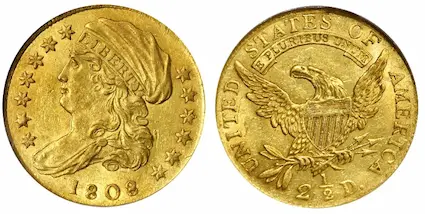
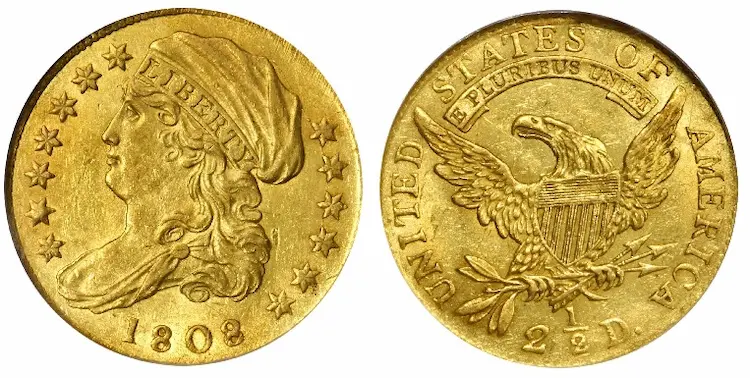
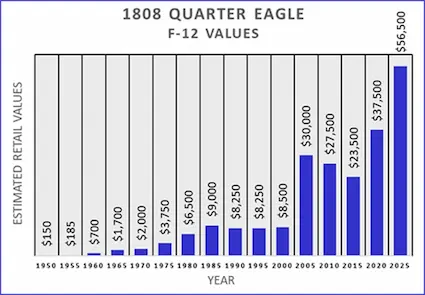
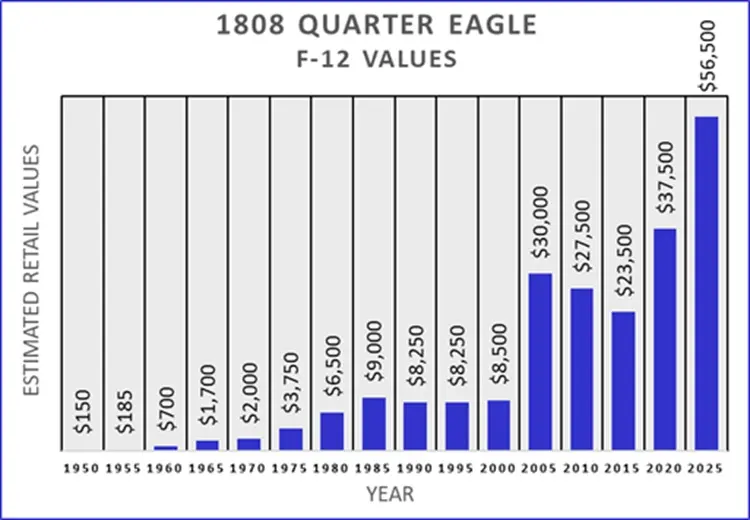
For the second example, let’s roll out the 1901-S Barber quarter. Of all the Barber quarter dates (minted from 1892-1916), the 1901-S is by far the toughest to find. The 1901-S had a paltry mintage of 72,664 to begin with, and of those, according to some investigators, more than a few perished in the 1906 San Francisco earthquake and fire, further reducing its numbers.(5)
No set of Barber quarters can be completed without the 1901-S. Pressure from collectors chasing after a limited survivorship has predictably elevated the 1901-S to “King of the Hill” in the Barber quarter series, where it has reigned for many decades. Can we say this is a high quality, key date coin as well? Yes, absolutely!
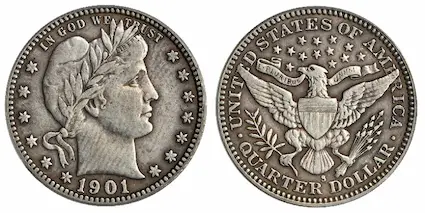
For the second example, let’s roll out the 1901-S Barber quarter. Of all the Barber quarter dates (minted from 1892-1916), the 1901-S is by far the toughest to find. The 1901-S had a paltry mintage of 72,664 to begin with, and of those, according to some investigators, more than a few perished in the 1906 San Francisco earthquake and fire, further reducing its numbers.(5)
No set of Barber quarters can be completed without the 1901-S. Pressure from collectors chasing after a limited survivorship has predictably elevated the 1901-S to “King of the Hill” in the Barber quarter series, where it has reigned for many decades. Can we say this is a high quality, key date coin as well? Yes, absolutely!
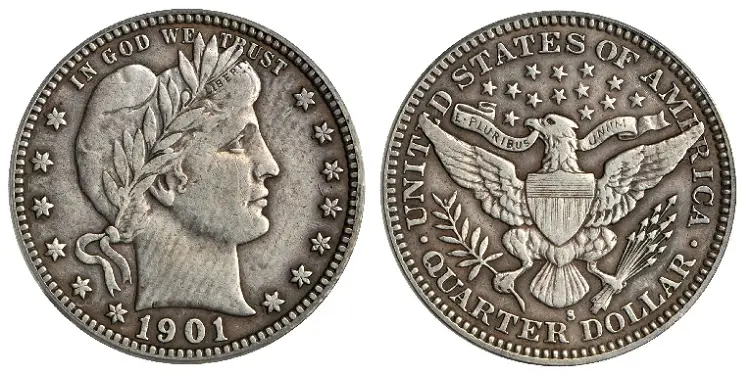
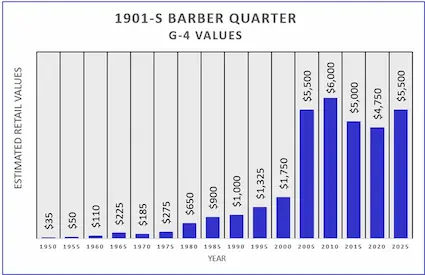
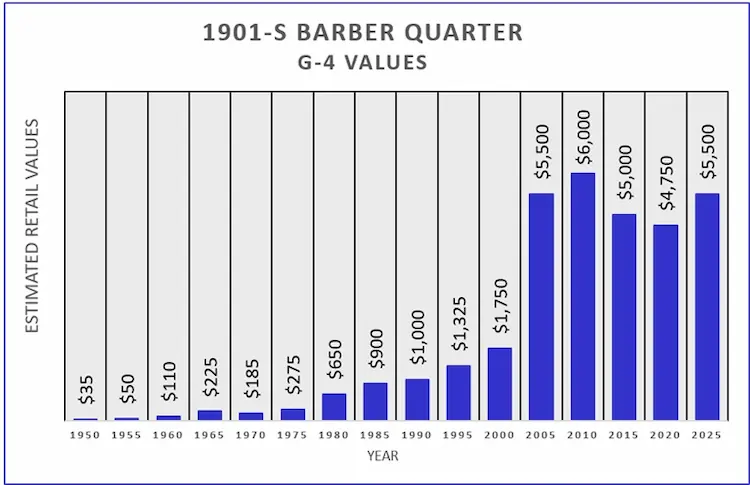
In addition to quality being measured on a grading scale to indicate its physical state of preservation, we now see that another way to define a quality coin is based on a combination of its collector desirability and available supply. A coin of relative scarcity that is eagerly sought by a significant segment of collecting community embodies the second definition of high quality.
It's no coincidence the second category of quality coins tends to boast the strongest price advancements in the long run.
Actually, this thought process is embraced throughout this site, including on the home page as a Rare Coins 101 Axiom. The axiom is repeated here:
Key date rare coins that have historically been the most eagerly pursued by the collector base are the best bets for value appreciation in the years ahead.
If you’re the sort of collector aspiring to own coins destined for greatness but aren’t sure what to search for, you’re in luck. The Key Date Coin List is a gateway highlighting coins meeting this interpretation, supported by historical value trend data and other information.
Beginners can profit (both figuratively and literally) by perusing the Key Date Coin List as well, but it is strongly recommended to check off all the boxes to become a collector first before diving into major purchases.
There is yet a third manner in defining a high quality coin, and it too is meaningful for collectors with an eye toward future value appreciation. We will be hearing more about “eye” momentarily…


Eye Appeal
Of the three ways to evaluate quality, eye appeal can be the most nuanced, and yet in many situations, it is very important in determining value.
What is meant by eye appeal?
Eye appeal is the subjective overall attractiveness of a coin, based on types and severity of blemishes or marks (especially in focal areas), clean original surfaces, toning, original color, wear patterns (if any), strike sharpness, and more. When these facets combine to manifest an unaltered coin of increased aesthetic appearance, that coin may be said to have good, or positive eye appeal. The opposite of that is true as well.
A coin anywhere on the grading spectrum, from the heavily worn to the pristine, may be evaluated for eye appeal.
There really isn’t a way to measure or quantify eye appeal. However, recognizing it when it occurs is an instinct collectors may develop with experience. When given a choice between two coins nearly equal in all aspects other than eye appeal, the majority of collectors may agree on the coin having the greatest eye appeal, especially if the aesthetic divergence is dramatic.
If you’re new to coin collecting, perhaps you’re wondering if you have what it takes to understand the subtle factors involved with judging eye appeal.
What follows is a brief test designed to discover if you have the innate talent to recognize eye appeal (this "test" really isn't a test -- it is a night/day comparison designed to clearly illustrate the concept of eye appeal).
For each of the following coin pairs, select the coin, in your opinion, having the greatest eye appeal.



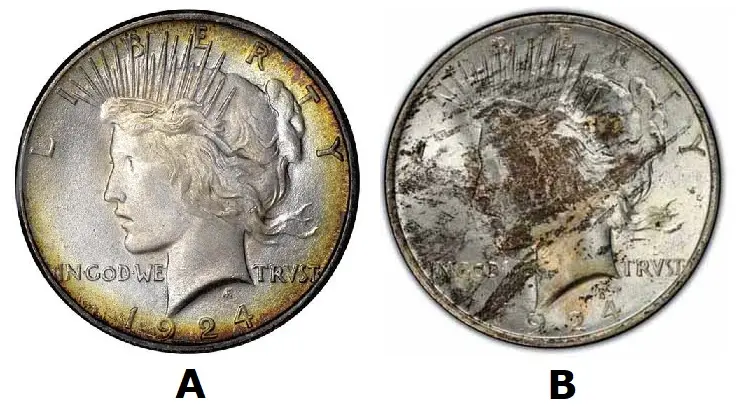
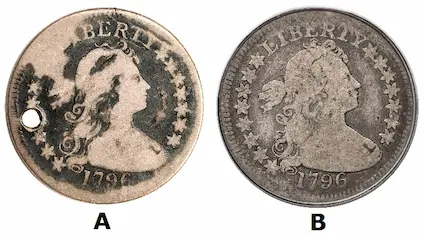
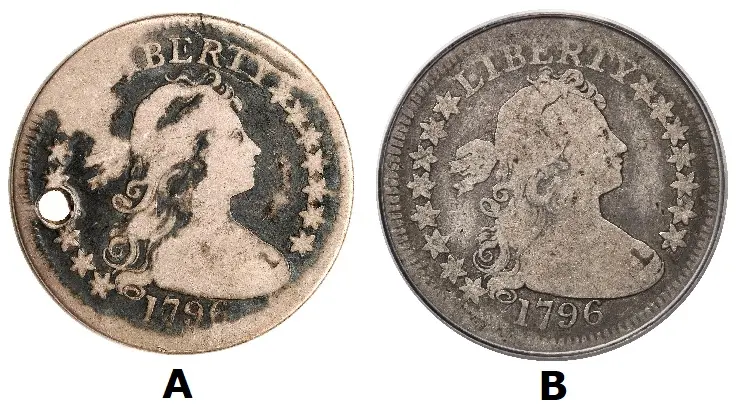
Most of you probably selected B-A-B. Excellent! If you picked something else, perhaps coin collecting is not for you (just kidding, of course).
It’s not always this easy to evaluate eye appeal. In these situations, the degree of eye appeal truly is dependent on opinion: What looks fantastic to one collector might evoke a “so what” from someone else. Have a look at the trio of coins just below. All were described as having "above average" toning, but what is your opinion?
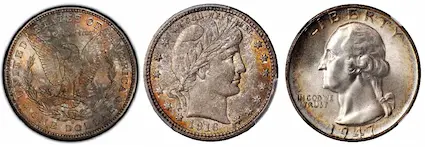
Most of you probably selected B-A-B. Excellent! If you picked something else, perhaps coin collecting is not for you (just kidding, of course).
It’s not always this easy to evaluate eye appeal. In these situations, the degree of eye appeal truly is dependent on opinion: What looks fantastic to one collector might evoke a “so what” from someone else. Have a look at the trio of coins just below. All were described as having "above average" toning, but what is your opinion?
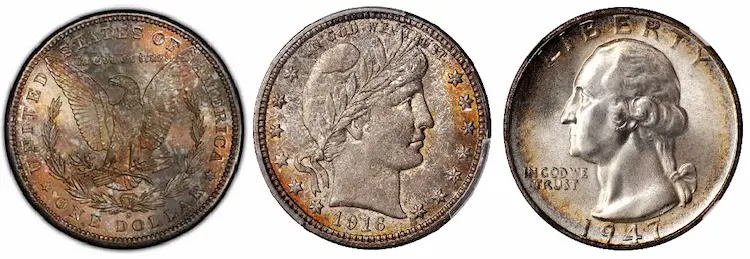
And then there are the coins with "no doubter" eye appeal: Those that virtually every collector emphatically agrees have high quality aesthetics, well beyond normal.
These superior eye appeal coins may be characterized by colorfully iridescent, balanced toning, brilliant luster or reflectivity, exquisite detail sharpness, and near pristine surfaces.
Check out this screamer:

And then there are the coins with "no doubter" eye appeal: Those that virtually every collector emphatically agrees have high quality aesthetics, well beyond normal.
These superior eye appeal coins may be characterized by colorfully iridescent, balanced toning, brilliant luster or reflectivity, exquisite detail sharpness, and near pristine surfaces.
Check out this screamer:
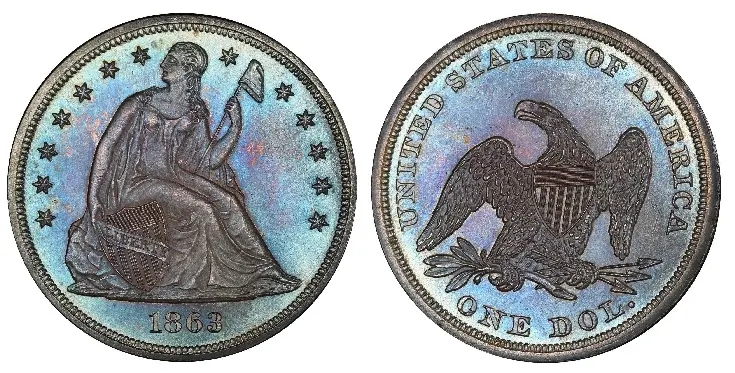
Intuitively, for classic collectible coins, there are more of them on the negative end of the eye appeal gamut compared to those occupying the high side. (It would be fun to see a statistical analysis of eye appeal. It would probably not resemble a uniform distribution, but what would it look like? Hmmm... might be a good project to undertake someday)
As we continue to discuss the concept of eye appeal, it would be instructive to explain how most coins with negative eye appeal got that way.
Damaged Coins
These are coins that have been holed, gashed, bent, stained, environmentally attacked (causing discoloration or corrosion), or in some way mutilated from their original form.
Coins displaying spotty, streaky, or multi-coloration effects almost always possess less eye appeal compared to coins with uniform, smooth coloration.
Typically, older coins with heavy circulation wear have suffered some damage during their extensive travels (note: wear itself is not considered damage).

These are coins that have been holed, gashed, bent, stained, environmentally attacked (causing discoloration or corrosion), or in some way mutilated from their original form.
Coins displaying spotty, streaky, or multi-coloration effects almost always possess less eye appeal compared to coins with uniform, smooth coloration.
Typically, older coins with heavy circulation wear have suffered some damage during their extensive travels (note: wear itself is not considered damage).
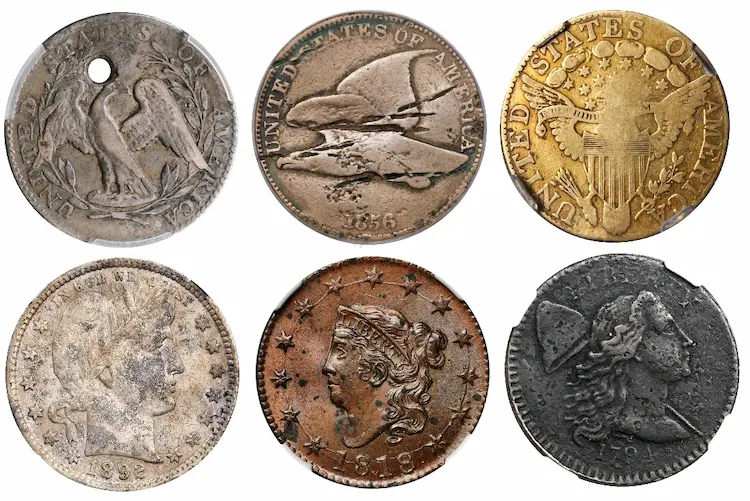
Cleaned Coins
These are coins having their originality marred through the improper application of cleaning chemicals or abrasives, leaving observable surface reactions and/or small scratches. When a coin is improperly cleaned, small amounts of metal are forcibly removed from the surface or relocated to simulate mint luster.
The vast majority of speciously cleaned coins are never associated with good eye appeal by veteran collectors and are valued accordingly, which brings us to another point...
Some improperly cleaned coins are so skillfully done it takes an expert using high magnification to detect the telltale clues. All the more reason to buy only from trustworthy sellers. (Note: There are a few instances when a coin can and perhaps should be cleaned professionally and that DOES NOT result in a coin of diminished value. The Numismatic Conservation Service is a leader in this area).
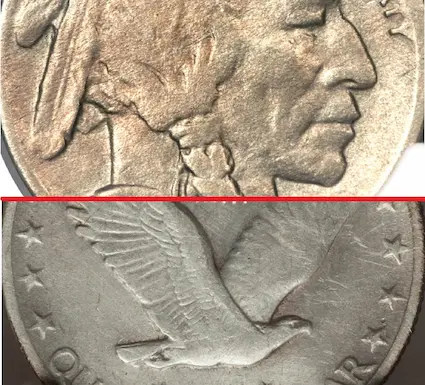
These are coins having their originality marred through the improper application of cleaning chemicals or abrasives, leaving observable surface reactions and/or small scratches. When a coin is improperly cleaned, small amounts of metal are forcibly removed from the surface.
The vast majority of speciously cleaned coins are never associated with good eye appeal by veteran collectors and are valued accordingly, which brings us to another point...
Some improperly cleaned coins are so skillfully done it takes an expert using high magnification to detect the telltale clues. All the more reason to buy only from trustworthy sellers. (Note: There are a few instances when a coin can and perhaps should be cleaned professionally and that DOES NOT result in a coin of diminished value. The Numismatic Conservation Service is a leader in this area).
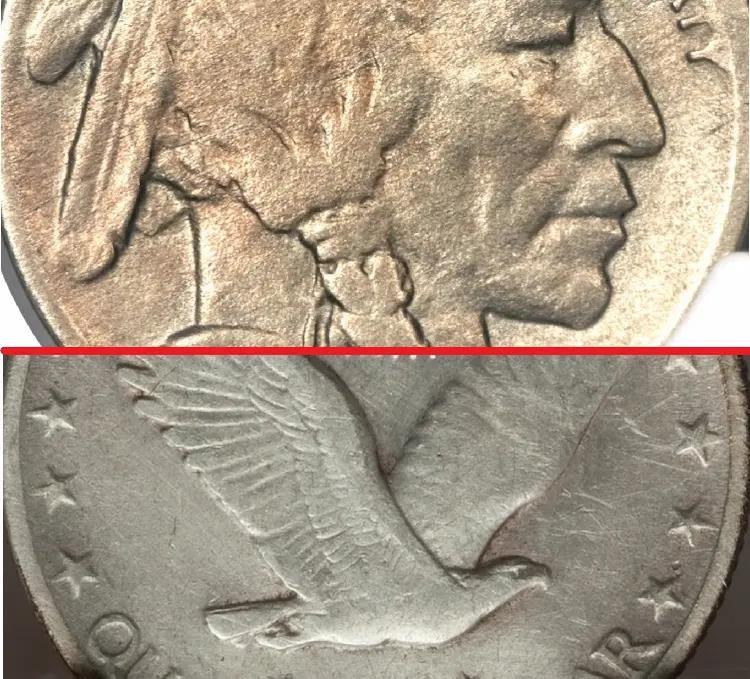
Proper coin cleaning requires considerable expertise. It is not the same as painting a wall with latex paint, where if you make a mistake, it is possible to start over. You can do great harm to a coin with unsound cleaning techniques, and there is no UNDO button. Once it's ruined, it's ruined forever. That brings us to this Rare Coins 101 Axiom:
Unless you are a coin restoration expert, never attempt to clean a coin you consider to be valuable.
Artificially Toned Coins
Toning is the natural coloration of a coin caused by exposure to environmental conditions over a long period of time (but not with the same result as when environmentally attacked).
In some circumstances, natural toning randomly results in an appealing rainbow hue and is appreciated by many collectors. Other coins with natural toning may be less attractive. Darkish toning is often downright unattractive, and is viewed with less favor.
The molecular composition of copper and silver coins cause them to be more reactive with the environment compared to gold coins.
Coins that are imparted with unnatural coloration by applying chemicals or other treatments are deemed to be artificially toned and are held in near universal disdain.
"Coin doctors" have tried many techniques to artificially tone coins. Some of their methods include bluing materials employed by gunsmiths, or coating their coins with various substances before baking them on an oven. Sometimes chemical dipping is the chosen method.(11)
No coin, no matter how beautifully toned, can ever rate high in eye appeal if artificially toned. Here again, experts are seldom fooled by artificial toning.
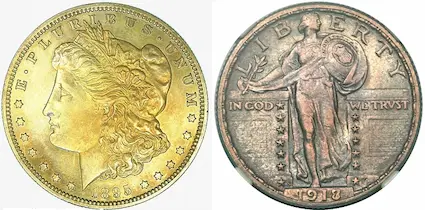
Toning is the natural coloration of a coin caused by exposure to environmental conditions over a long period of time (but not with the same result as when environmentally attacked).
In some circumstances, natural toning randomly results in an appealing rainbow hue and is appreciated by many collectors. Other coins with natural toning may be less attractive. Darkish toning is often downright unattractive, and is viewed with less favor.
The molecular composition of copper and silver coins cause them to be more reactive with the environment compared to gold coins.
Coins exhibiting artificial toning -- achieved through the application of chemicals or other treatments to produce unnatural coloration -- are held in near universal disdain within the numismatic community.
"Coin doctors" have tried many techniques to artificially tone coins. Some of their methods include bluing materials employed by gunsmiths, or coating their coins with various substances before baking them on an oven. Sometimes chemical dipping is the chosen method.(11)
No coin, no matter how beautifully toned, can ever rate high in eye appeal if artificially toned. Here again, experts are seldom fooled by artificial toning.
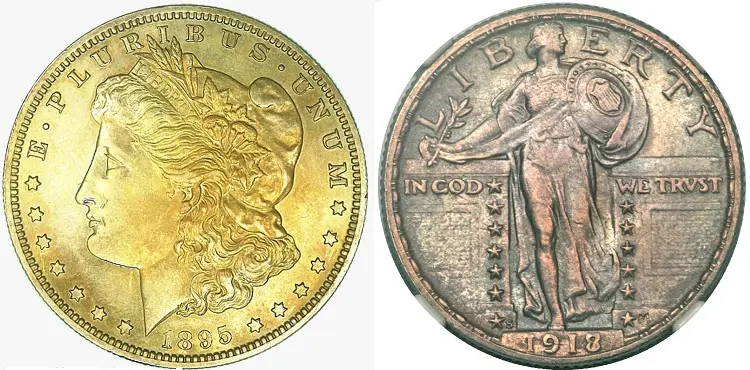
Repaired Coins
It is possible to repair a coin that has been holed or damaged in some way. Plugging or polishing are commonly employed repair techniques. No matter how well done, a repaired coin can never shake off this stigma and be rated positively for eye appeal.
Directly below are three coins that qualify as repaired coins. All sold for far less than had they not been damaged and repaired.
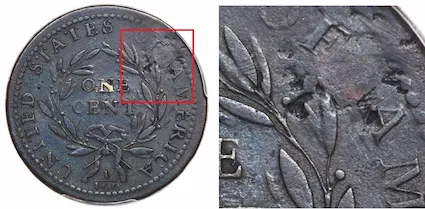
It is possible to repair a coin that has been holed or damaged in some way. Plugging or polishing are commonly employed repair techniques. No matter how well done, a repaired coin can never shake off this stigma and be rated positively for eye appeal.
Directly below are three coins that qualify as repaired coins. All sold for far less than had they not been damaged and repaired.
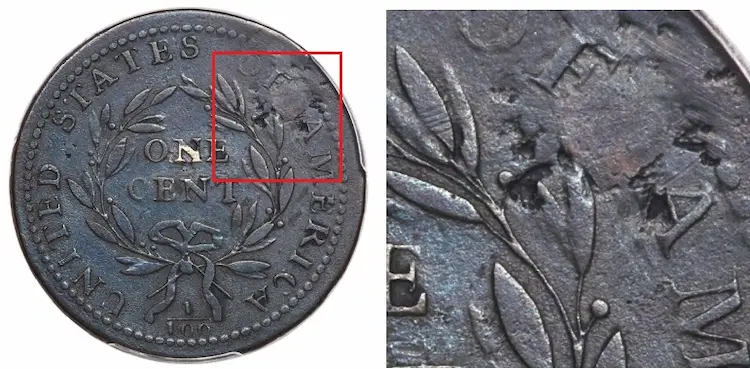


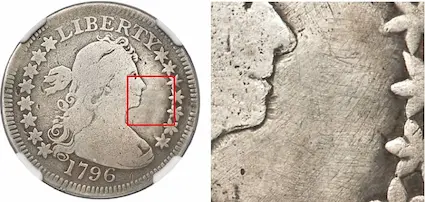
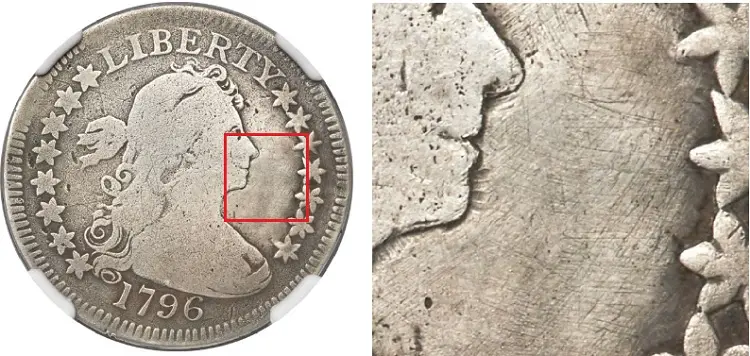
The "Problem Coin" Category
Coins plagued by any of the negative characteristics above are often lumped together in something called the “problem coin” category. A problem coin is usually valued substantially less than other examples of the same coin in problem-free condition.
That’s because the small percentage that escaped the problem coin fate generally has superior eye appeal, comparatively speaking. Discerning collectors clamor for this type of high quality eye appeal, even to the point of paying substantial premiums.
It is considered acceptable to sell a problem coin, as long as the grading description accurately indicates the type and severity of the inherent problem(s).
The Importance of Eye Appeal Looking Forward
So why is this conversation about eye appeal important to a collector starting out?
There are several reasons...
Eye appeal can and does factor in a coin’s numeric grade. In addition, a certified coin with exceptionally good eye appeal may earn a special indicator calling attention to this fact. For all collectors, new and old, it is important to understand positive eye appeal usually enhances value.
Rare Coins 101 has a full section devoted to coin grading, where the role of eye appeal is explored in greater context.
Another thing -- For the collector aspiring to own coins that will generally outpace the field in terms of percentage gains, acquiring coins with above average eye appeal is conducive in attaining this goal. This holds true at the lower end of the grade range to the highest Mint State and Proof specimens (don't forget -- eye appeal doesn't pertain strictly to higher grade coins -- it can apply to heavily worn coins likewise).
Rare coins appearing on the Key Date Coin List that are also blessed with good eye appeal should have heightened expectations of enviable returns.
As we move further into the 21st century, we can see with 20/20 vision the continued prominence of eye appeal in the coin market. It separates the upper crust of quality rare coins from the competition, attracting the attention of selective buyers. This added pressure naturally drives prices higher and faster for those relative few coins of high quality eye appeal, leading to this Rare Coins 101 Axiom:
Collectors expecting their coins to impressively increase in future value would do well to seek out problem-free coins with good eye appeal.
Dare we call this type of collector an investor? Sure, why not? A perceptive collector who firmly grasps the nuances and importance of eye appeal may well be ready for the investor arena. The primary warning is to be careful not to get drawn into a bidding war against an overly motivated rival and pay too much! Knowing when to walk away is a wisdom that comes with experience.
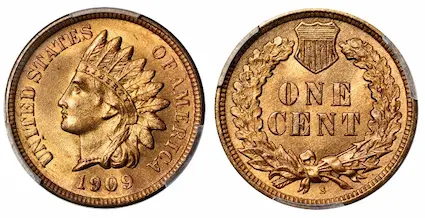
Dare we call this type of collector an investor? Sure, why not? A collector who firmly grasps the nuances and importance of eye appeal may well be ready for the investor arena. The primary warning is to be careful not to get drawn into a bidding war against an overly motivated rival and pay too much! Knowing when to walk away is a wisdom that comes with experience.
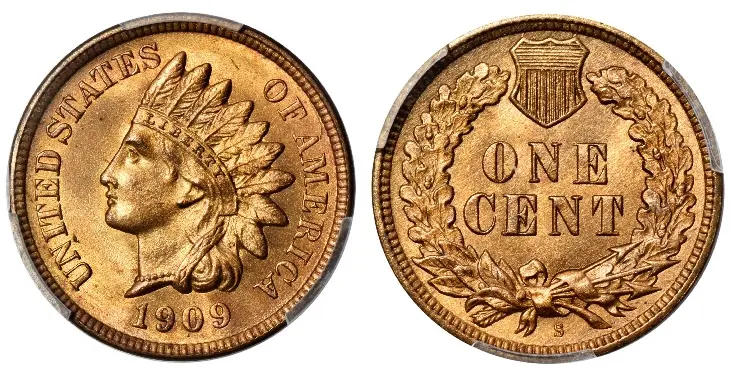
One more thing to say before closing out this chapter…
Nothing here is meant to discourage a collector from wanting a coin of “low quality”. Not everyone can have a rare date in MS-65 with beautiful toning. Besides, those lesser coins need homes, too.
A holed 1855 Coronet Head large cent in FR-2 condition tainted with corrosion is every bit the time traveler as other coins from past generations. If a young collector with meager income aims to build a cent type set, this coin fulfills an immediate yearning and may act as a springboard toward greater endeavors.
This reminds me of a story…
As a 12-year-old, I started collecting Indian Head cents. No way did I have the money to acquire the key dates, nor even the semi-keys. One day, while shuffling through a local coin dealer’s bargain bin, I gleefully stumbled on a badly damaged 1870 cent. This is one of the tougher dates in the series. I don’t remember what the price tag was, but it could not have been much because I actually had enough money in my pocket to buy it. I was so proud, admiring how it fit the vacant slot of the Whitman folder.
Becoming the new owner of that banged up 1870 cent whetted my appetite to learn more about coin collecting. It wasn’t until many years later that I finally completed the entire set of Indian Head cents. Upon reminiscing, not even the occasion when I reeled in the 1877 delivered as much joy as bringing home that “low quality” 1870 album-filler cent.
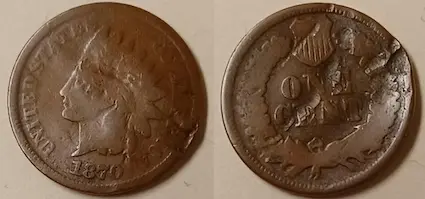
As a 12-year-old, I started collecting Indian Head cents. No way did I have the money to acquire the key dates, nor even the semi-keys. One day, while shuffling through a local coin dealer’s bargain bin, I gleefully stumbled on a badly damaged 1870 cent. This is one of the tougher dates in the series. I don’t remember what the price tag was, but it could not have been much because I actually had enough money in my pocket to buy it. I was so proud, admiring how it fit the vacant slot of the Whitman folder.
Becoming the new owner of that banged up 1870 cent whetted my appetite to learn more about coin collecting. It wasn’t until many years later that I finally completed the entire set of Indian Head cents. Upon reminiscing, not even the occasion when I reeled in the 1877 delivered as much joy as bringing home that “low quality” 1870 album-filler cent.
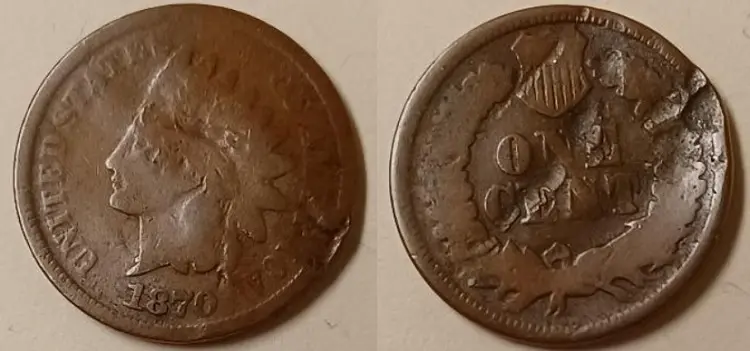
Understanding the concept of high quality coins is important for collectors of all stripes, including beginners. Should collectors seek out only high quality coins? There is no absolute correct answer. It really depends on where you’re at in the hobby today, what your goals are, and how far you think you might go with it.
Quick Links to Other "Getting Started in Coin Collecting" Chapters...
The next chapter in this section is Develop a Passion for Coins.
Use the links directly below to navigate the "Getting Started in Coin Collecting" section.
- Coin Grading Basics
- Absorb Knowledge and Stay Current
- What to Collect?
- Understanding Quality (the current chapter)
- Develop a Passion for Coins
- Get to Know People
- Handling & Storing Numismatic Treasures
- Coin Lingo
- Best Places to Buy Coins
All the chapters referenced above are accessible from any other chapter in this section. Thus, no need to return to the "Getting Started in Coin Collecting" Introductory page to link to other chapters.
Sources
1. Gilkes, Paul, Senior Editor, U.S. Coins. Coin World Domestic Values. Sidney, OH. Amos Media Company. 2024.
2. Breen, Walter, Walter Breen's Complete Encyclopedia of U.S. and Colonial Coins. New York, NY. F.C.I. Press/Doubleday, 1988.
3. Goevert, Daniel J. Value Trends of United States Coins. Wichita, KS. Heritage Coin Books, 1987.
4. Gilkes, Coin World Domestic Values.
5. Bellavin, Lisa: Did the Earthquake Make Rarities?. Numismatic News, 2011.
6. Goevert, Value Trends of United States Coins.
7. Gilkes, Coin World Domestic Values.
8. 2012 November 29 - December 2 US Coin Signature Auction - Houston #1177. 1918/7-D 5C -- Improperly Cleaned -- NGC Details. XF. FS-101.
9. 2012 March 8-11 US Coin Signature Auction - New York #1168. 1918/7-S 25C -- Harshly Cleaned -- NGC Details. VF. FS-101.
10. Gilkes, Coin World Domestic Values.
11. Gibbs, William T. 2001 Guide to U.S. Coins, Prices & Value Trends. New York, NY. Penguin Putnam Inc. 2000.
12. 2021 January 20 - 24 FUN US Coins Signature Auction #1326. 1793 1C Liberty Cap, S-14, B-17, Low R.5 -- Plugged -- PCGS Genuine. VG Details.
13. Gilkes, Coin World Domestic Values.
14. Gilkes, Coin World Domestic Values.
15. 2021 April 22 - 25 Central States US Coins Signature Auction #1329. 1808 $5 Wide 5D, BD-4, High R.3--Repaired--PCGS Genuine. Unc Details.
16. 2020 August 3 - 9 US Coins Signature Auction #1318. 1796 25C B-2, R.3 -- Repaired -- NGC Details. VG.
17. Gilkes, Coin World Domestic Values.
18. The November 2021 Baltimore Auction. 1909-S Indian Cent. MS-66 RD (PCGS). CAC.
19. Gilkes, Coin World Domestic Values.

